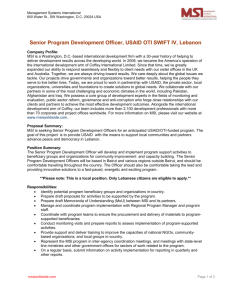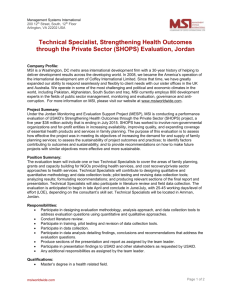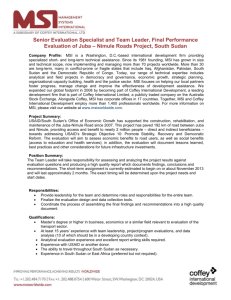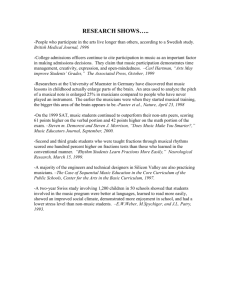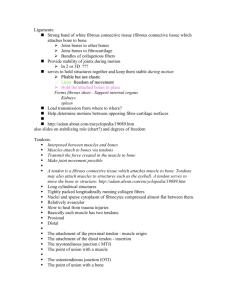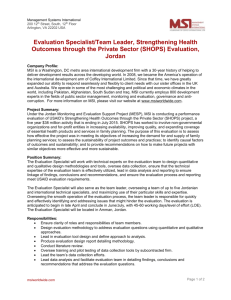Musicians and MSI: Symptoms and types of injuries
advertisement
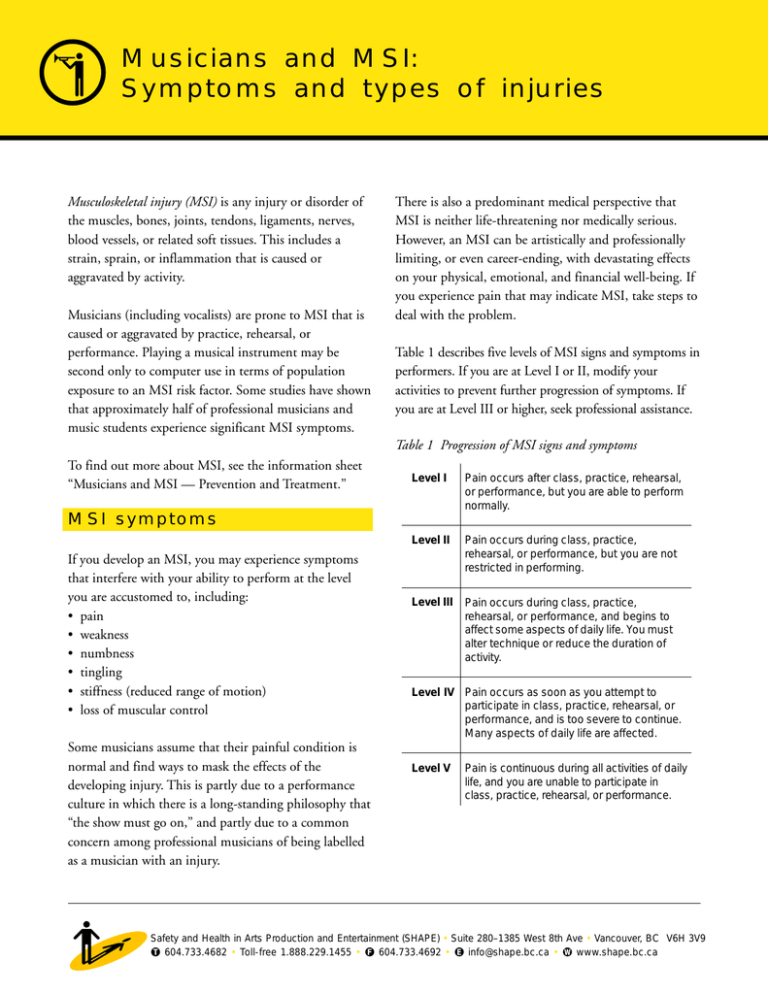
Musicians and MSI: Symptoms and types of injuries Musculoskeletal injury (MSI) is any injury or disorder of the muscles, bones, joints, tendons, ligaments, nerves, blood vessels, or related soft tissues. This includes a strain, sprain, or inflammation that is caused or aggravated by activity. Musicians (including vocalists) are prone to MSI that is caused or aggravated by practice, rehearsal, or performance. Playing a musical instrument may be second only to computer use in terms of population exposure to an MSI risk factor. Some studies have shown that approximately half of professional musicians and music students experience significant MSI symptoms. There is also a predominant medical perspective that MSI is neither life-threatening nor medically serious. However, an MSI can be artistically and professionally limiting, or even career-ending, with devastating effects on your physical, emotional, and financial well-being. If you experience pain that may indicate MSI, take steps to deal with the problem. Table 1 describes five levels of MSI signs and symptoms in performers. If you are at Level I or II, modify your activities to prevent further progression of symptoms. If you are at Level III or higher, seek professional assistance. Table 1 Progression of MSI signs and symptoms To find out more about MSI, see the information sheet “Musicians and MSI — Prevention and Treatment.” Level I Pain occurs after class, practice, rehearsal, or performance, but you are able to perform normally. Level II Pain occurs during class, practice, rehearsal, or performance, but you are not restricted in performing. Level III Pain occurs during class, practice, rehearsal, or performance, and begins to affect some aspects of daily life. You must alter technique or reduce the duration of activity. MSI symptoms If you develop an MSI, you may experience symptoms that interfere with your ability to perform at the level you are accustomed to, including: • pain • weakness • numbness • tingling • stiffness (reduced range of motion) • loss of muscular control Some musicians assume that their painful condition is normal and find ways to mask the effects of the developing injury. This is partly due to a performance culture in which there is a long-standing philosophy that “the show must go on,” and partly due to a common concern among professional musicians of being labelled as a musician with an injury. Level IV Pain occurs as soon as you attempt to participate in class, practice, rehearsal, or performance, and is too severe to continue. Many aspects of daily life are affected. Level V Pain is continuous during all activities of daily life, and you are unable to participate in class, practice, rehearsal, or performance. Safety and Health in Arts Production and Entertainment (SHAPE) • Suite 280–1385 West 8th Ave • Vancouver, BC V6H 3V9 604.733.4682 • Toll-free 1.888.229.1455 • 604.733.4692 • info@shape.bc.ca • www.shape.bc.ca 2 Musicians and MSI Tendon and muscle disorders Tendon and muscle disorders that affect musicians include tendinitis and tenosynovitis, strains, and focal dystonia. Figure 1 MSIs common to musicians Jaw and head Temporomandibular joint (TMJ) dysfunction Tendinitis and tenosynovitis Tendons are rope-like structures made of strong, smooth fibres that do not stretch. During movement, tendons normally slide within a lubricated tendon sheath. Excessive tension in the tendon or the friction of repeated movements can result in irritation of the tendon (tendinitis) or sheath (tenosynovitis). Awkward postures that stretch or bend tendons around joints increase tension and friction, contributing to the risk of MSIs such as tendinitis. Shoulder Shoulder impingement syndrome Back and neck Spondylolysis Back and neck pain Hand and arm Carpal tunnel syndrome Cubital tunnel syndrome Thoracic outlet syndrome De Quervain's syndrome Lateral epicondylitis (tennis elbow) Medial epicondylitis (golfer’s elbow) Focal dystonia Arthritis Strains A strain is a stretch or tear of muscle fibres or connecting tissues such as tendons or fascia. Chronic strains result from overuse of muscles. Acute strains result from traumatic injuries to muscles. Excessive tension or impacts can eventually tear tendon fibres much like a rope can become frayed. Tendon strains usually result in the formation of scar tissue. Repeatedly strained tendons can become thickened, bumpy, and irregular. Prolonged irritation of the tendon sheath can cause the lining of the sheath to thicken and constrict, making it difficult for the tendon to slide in the sheath. Focal dystonia Focal dystonia is a muscle malfunction at a specific location, which may result in: • cramping • involuntary flexing or straightening of a joint • a sense of fatigue • loss of coordination Focal dystonia may or may not be painful, but it will interfere with your ability to play an instrument. Muscle cramping is not necessarily focal dystonia. Cramping or stiffness may occur as a result of the fatigue induced by a particularly long or difficult practice session, rehearsal, or performance. However, focal dystonia is a condition in which muscle dysfunction can occur in the absence of fatigue. Focal dystonia typically affects the: • hands and fingers of string and keyboard players • feet of drummers • vocal chords of vocalists • embouchure of brass players You may experience referred symptoms in other parts of your body when cramping or spasm occurs in the neck or back muscles. Symptoms and types of injuries 3 Tendon and muscle disorders in specific body parts Each musical instrument has particular physical and postural demands that place stresses on the body. Knowing the parts of your body that are more prone to injury may help you prevent MSI. Table 2 Tendon and muscle disorders in specific body parts Body parts What goes wrong? Which instruments/who is it usually associated with? hands, wrists, and forearms Muscle strains occur in the small hand muscles that control lateral finger movement and finger spread, as well as those that flex the finger at the large metacarpal joint. • keyboards • guitar De Quervain’s syndrome is pain in the tendons at the base of the thumb and on the thumb side of the forearm. It becomes painful to move the thumb away from the hand or engage in activities that require a firm grip or twisting motion. • clarinet and oboe • flute • keyboards • percussion Irritation occurs in the muscles and tendons in the forearm that flex and extend the wrist. Instruments that require awkward postures, force, and fine coordinated movement of the hands and fingers, including strings, oboe, French horn, and flute. Epicondylitis is elbow soreness where the forearm muscles attach to the bone on the elbow’s outer edge (lateral epicondylitis) or inner edge (medial epicondylitis). It may also cause forearm or wrist pain. Instruments that require complex postures with rotation of the forearm, bending of the wrist, and independent finger movement, including keyboards, percussion, clarinet, oboe, harp, and trombone. Rotator cuff tendinitis is irritation of the shoulder tendons. Pain usually occurs in the top or front part of the shoulder, or on the outer part of the upper arm. Instruments that require the arm to be in a raised position with the elbow pointing outward or forward, including violin, viola, cello, double bass, and bassoon. elbows and shoulders back and neck Low back pain is common among musicians. Upper back and neck pain are common in certain musicians. head and face Musicians sitting in restricted postures for long periods. Instruments that require specific playing postures and force, particularly of the head and upper arms, to support the instrument, including violin, viola, flute, harp, saxophone, keyboard, double bass, and bassoon. • vocalists Muscle strains occur in the muscle that controls the shape of the mouth and lips (orbicularis oris). • horn players Disorders occur in the temporomandibular joint (TMJ), where the jaw joins the skull in front of the ears. Pain may seem to be a headache or involve the face and neck, and is usually related to either excessive muscle tension (for example, teeth clenching) or to degradation of the joint itself. Instruments that require careful and sustained jaw positioning: • violin and viola • saxophone • clarinet • French horn Note: The material in this publication is intended only as educational information and is not meant to replace the knowledge and services of qualified medical professionals. Furthermore, this publication does not replace the Occupational Health and Safety Regulation administered by the Workers’ Compensation Board of British Columbia. Employers and workers should always refer to the Regulation for specific requirements that apply to their activities. 4 Musicians and MSI Nerve compression or entrapment Nerve compression or entrapment results when there is pressure on or irritation of motor or sensory nerves. This tends to happen at specific locations: where the nerve crosses a joint or where it travels through areas that are restricted in size by surrounding tissues. Aggravation of tendons or muscles that share space with nerves can result in local swelling that compresses the nerves. Table 3 Nerve compression or entrapment injuries Injury What is it? What are the symptoms? Who does it usually affect? carpal tunnel syndrome • irritation of tendons causes swelling within the carpal tunnel and compression of the median nerve at the wrist numbness, tingling, or pain in the thumb, index, and middle fingers • violin and viola players (left) • guitar players (left) (particularly if playing in the 12th or 13th position for too long) • thought to be related to activities that require repetitive or sustained wrist flexion, particularly with a lot of finger movement cubital tunnel syndrome compression or entrapment of the ulnar nerve at the inside groove of the elbow • violin and viola players (left) numbness, tingling, pain, or loss of coordination in the • guitar players (left) fourth (ring) and fifth (little) fingers, and pain at the elbow thoracic outlet syndrome compression of the group of nerves travelling toward the arm between the first rib and collarbone similar symptoms to carpal tunnel syndrome or cubital tunnel syndrome • violin and viola players (left) • flute players (left and right) • keyboard players (left and right) • guitar players (left) sciatica irritation or compression of the sciatic nerve as it leaves the spine in the low back and travels down into the leg pain in the legs and buttocks • musicians who sit for prolonged periods, particularly if bent slightly forward or rotated to the side • musicians who sit on a chair or bench that is too high or has a square edge on the front of the seat pan © 2003 Safety and Health in Arts Production and Entertainment (SHAPE). All rights reserved. SHAPE encourages the copying, reproduction, and distribution of this document to promote health and safety in the workplace, provided that SHAPE is acknowledged. However, no part of this publication may be copied, reproduced, or distributed for profit or other commercial enterprise, nor may any part be incorporated into any other publication, without written permission of SHAPE. Revised Dec/03
